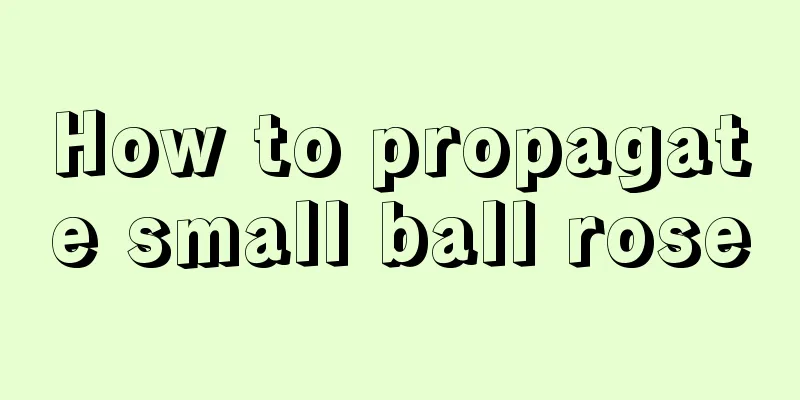Can roses be pruned in summer?

|
Many people like to grow roses at home. They are fragrant and beautiful, and seeing the flowers will make you feel good. However, when the temperature rises in summer, roses grow slowly. So can roses be pruned heavily in summer? Let’s learn more about it below. Can roses be pruned in summer? Roses can also be pruned in summer. During the hot summer season, as long as the temperature exceeds 35 degrees, the roses will grow slowly and the flowers will wither as soon as they bloom. In serious cases, diseases and pests may occur, causing the rose stems to turn black and wither. In this case, the roses need to be treated more harshly, that is, they need to be heavily pruned. Heavy pruning of roses should be done after the growth of roses slows down. Leave about 3 to 5 cm of rose branches, and then cut off all the branches above. In this way, the branches that grow from the rose will be more vigorous, and the flowers will be larger and brighter. Notes on Rose Pruning in Summer 1. Don’t prune too harshly For roses that have entered a dormant period or are growing slowly, you must be careful not to be too harsh when pruning them, because the growth activity of these roses has decreased in the summer. After pruning, the wounds heal slowly and it is difficult to grow new branches and leaves quickly. The prolonged wound healing time will undoubtedly increase the chance of invasion by fungi and insects, which can easily cause the rose to become sick. 2. Do not prune on rainy days If you need to prune roses in the summer, never do it on rainy days. This is because there are too many impurities in the rainwater, and it may also carry bacteria and insect eggs. If you prune the roses at this time and let them get wet in the rain, it will easily cause wound infection and black stems to appear. Pruning roses should be done on a sunny day, and it is best to use special gardening scissors to ensure that the branches can be cut in one go, leaving a smooth wound that heals quickly. 3. Supplement nutrition after pruning For rose varieties that are growing vigorously and still blooming, they should be given appropriate nutritional supplements after pruning. Every 15 days or so, dilute the rose-specific organic nutrient solution 1000 times with water, and water the roses along the edge of the pot. The rose absorbs sufficient nutrients, the plant recovers quickly, and when it gathers enough strength, it can bloom again. 4. Do not forcibly cut yellow leaves The weather is hot in summer, and in order to reduce the plant's own nutrient consumption, old leaves will turn yellow. This is a natural phenomenon. There is no need to worry too much, nor is there any need to forcibly cut off these yellow leaves, because these yellow leaves are caused by the natural metabolism of the rose and will not continue to consume the nutrients of the plant. If you cut it off forcefully, it may cause unnecessary wounds and increase the chance of the rose becoming diseased. That’s it |
<<: Sunshine Rose Seedless Treatment Formula
>>: Sunflower planting process record
Recommend
How much garlic yield per mu
Garlic yield per mu Garlic is a high-yield vegeta...
How to prevent and treat common diseases of chrysanthemum
Black spot symptom As long as the disease harms t...
Is Epiphyllum a king of flowers? Does it bloom at night?
1. Is it the Queen of Flowers? Epiphyllum is a pl...
How to grow morning glory in autumn
1. Planting The branches of the plant will be com...
Can leeks be transplanted in November? Leek root transplanting planting methods and precautions
Leek is one of the most common vegetables in our ...
How to prolong the flowering period of Verbena
1. Soil selection. If you want to extend its flow...
New high-end vegetable varieties, the latest and most valuable vegetable varieties
Nowadays, with the progress of society, my countr...
How to maintain hydroponic yew
Hydroponic method of yew Clean the roots of the y...
How to plant a newly purchased Desert Rose
1. Bare root plants 1. Potting and soil selection...
How to prune plum trees?
Plum tree pruning time Plum trees are generally p...
What kind of fertilizer is good for Christmas cactus base fertilizer (base fertilizer application method)
Effect of base fertilizer on Christmas cactus The...
How to care for Ulmus pumila bonsai and what to pay attention to
Maintenance method of elm bonsai The small-leaved...
Is June Snow suitable for a deep or shallow pot?
Is June Snow suitable for a deep or shallow pot? ...
Can irises be transplanted in winter? When is the best time to transplant them?
Can irises be transplanted in winter? Irises can ...
How to make a bald tree split, how to prune it if it is too tall
1. How to fork 1. Ensure sunlight: Although the s...









